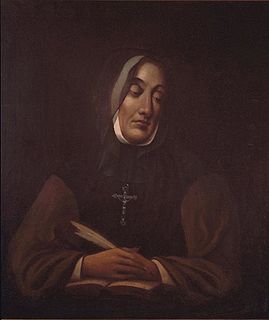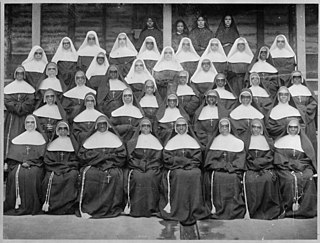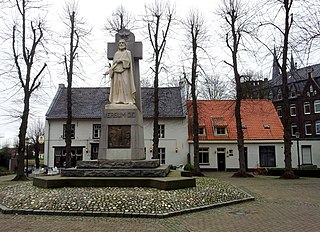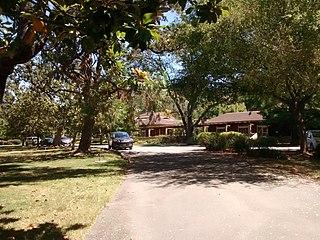Related Research Articles

The Order of Preachers, whose members are known as Dominicans, is a mendicant order of the Catholic Church founded in Toulouse, France, by the Spanish priest Saint Dominic. It was approved by Pope Honorius III via the Papal bull Religiosam vitam on 22 December 1216. Members of the order, who are referred to as Dominicans, generally carry the letters OP after their names, standing for Ordinis Praedicatorum, meaning of the Order of Preachers. Membership in the order includes friars, nuns, active sisters, and affiliated lay or secular Dominicans.
A religious order is a lineage of communities and organizations of people who live in some way set apart from society in accordance with their specific religious devotion, usually characterized by the principles of its founder's religious practice. The order is composed of laypeople and, in some orders, clergy. Religious orders exist in many of the world's religions.

The Order of the Visitation of Holy Mary or the Visitation Order is an enclosed Roman Catholic religious order for women. Members of the order are also known as the Salesian Sisters or, more commonly, as the Visitandines or Visitation Sisters.

Aquinas College is a small, Roman Catholic, liberal arts college in Grand Rapids, Michigan, United States. The College was ranked among the "Best Regional Universities – Midwest" by U.S. News & World Report in 2012.

The Sisters of Charity of Montreal, formerly called The Sisters of Charity of the Hôpital Général of Montreal and more commonly known as the Grey Nuns of Montreal, is a Canadian religious institute of Roman Catholic religious sisters, founded in 1737 by Saint Marguerite d'Youville, a young widow.

María Ascensión Nicol y Goñi, O.P., was a Spanish Roman Catholic religious sister of the Third Order of St. Dominic. She co-founded and was the first Prioress General of the Congregation of Dominican Missionary Sisters of the Rosary, which she helped to found in Peru.

The Sisters of St. Joseph, also known as the Congregation of the Sisters of St. Joseph and abbreviated C.S.J. or S.S.J., is a Roman Catholic religious congregation of women founded in Le Puy-en-Velay, France, in 1650. This Congregation, named for Saint Joseph, has approximately 14,000 members worldwide: about 7,000 in the United States; 2,000 in France; and are active in 50 other countries.

The Sisters, Servants of the Immaculate Heart of Mary (I.H.M.) is a Catholic religious institute of sisters, founded by Fr Louis Florent Gillet, CSsR, and a co-founder of the Oblate Sister of Providence, Mother Theresa Maxis Duchemin, in 1845.
The Third Order of Saint Francis, is a third order in the Franciscan order. The preaching of Francis of Assisi, as well as his example, exercised such an attraction on people that many married men and women wanted to join the First Order (friars) or the Second Order (nuns), but this being incompatible with their state of life, Francis found a middle way and in 1221 gave them a rule according to the Franciscan charism. Those following this rule became members of the Franciscan Third Order, sometimes called tertiaries. It includes religious congregations of men and women, known as Third Order Regulars; and fraternities of men and women, Third Order Seculars. The latter do not wear a religious habit, take vows, or live in community. However, they do gather together in community on a regular basis. "They make profession to live out the Gospel life and commit themselves to that living out the Gospel according to the example of Francis."
The Dominican Sisters of Mary, Mother of the Eucharist is a Catholic female religious institute of diocesan right based in Ann Arbor, Michigan which follows the charism of the Dominican Order. The congregation was founded in 1997 by four members of the Dominican Sisters of St. Cecilia in Nashville, Tennesse. As of 2018, it has 137 members.

The Adrian Dominican Sisters are a Catholic religious institute of Dominican sisters in the United States. Their motherhouse is in Adrian, Michigan. Their official title is the Congregation of the Most Holy Rosary.

The Sisters of the Holy Family are a Roman Catholic religious order based in New Orleans, Louisiana. They were founded in 1837 as the Sisters of the Presentation by Henriette DeLille, adopting the current name in 1842. They were the second Black religious order in the United States, after Mother Mary Lange's [[Oblate Sisters Hospitalières, who impressed her with her words of faith and acts of charity, around 1829, Henriette DeLille joined Juliette Gaudin, a Haitian, and Josephine Charles and began efforts to evangelize New Orleans slaves and free people of color. In 1836, Henriette and her friends formed the Congregation of the Sisters of the Presentation of the Blessed Virgin Mary, New Orleans' first confraternity of women of color. Their unofficial habit was a plain blue dress.
The Sisters of the Blessed Sacrament and Our Lady is an enclosed religious order and a reform of the Dominican Order devoted to the perpetual adoration of the Blessed Sacrament. The congregation was founded in Marseille in 1659 by a Dominican priest, Father Anthony Le Quieu.
The Dominican Sisters of Blauvelt are a religious congregation within the Dominican Order of religious sisters founded in 1890. They are based in the town of Blauvelt, New York, a northern suburb of New York City. Their traditional service has been childcare, both through teaching and caring for orphans.

The Dominican Order was first established in the United States by Edward Fenwick in the early 19th century. The first Dominican institution in the United States was the Province of Saint Joseph, which was established in 1805. Additionally, there have been numerous institutes of Dominican Sisters and Nuns.

Steyl is a village in the Tegelen district of the municipality of Venlo, the Netherlands. The village on the river Meuse is mainly known for its monasteries. In 2004, a section of the village including four monasteries was made a conservation area under protection of the Dutch heritage agency Rijksdienst voor het Cultureel Erfgoed.
The Dominican Sisters of Peace is a congregation of Dominican Sisters of apostolic life, founded on Easter Sunday, April 12, 2009, from the union of seven former Dominican foundations. With general offices in Columbus, Ohio, the congregation holds legal incorporation in the state of Kentucky, home of the founding community of earliest historical origin. In 2012, following a vote by their General Chapter, the Dominican sisters of Catherine de' Ricci became the eighth foundation to join the Dominican Sisters of Peace.

The Dominican Congregation of the Most Holy Name of Jesus, better known as the Dominican Sisters of San Rafael, is an institute of religious sisters belonging to the Third Order of St. Dominic founded in California in 1850 to teach the children of the new American territory. They also operate health facilities. They are located in San Rafael, California.

St. Joseph Academy, previously St. Joseph's College and Academy, was a Catholic girls' school in Adrian, Michigan, operating from 1896 to 2012. Established by Catholic nuns in a building that had previously operated as a hospital, the school operated as a high school and elementary school for most of its existence; the high school component closed in 1975.
References
- ↑ A Guide to Religious Ministries For Catholic Men and Women New Rochelle, NY: Catholic News, 2017
- 1 2 3 4 "Spectacular Fire Destroyed First Holy Rosary Academy in Essexville in 1904". MyBayCity.com.
- 1 2 "History". Sisters of Saint Dominic of Amityville, N.Y. Archived from the original on 2015-06-24.
- 1 2 3 4 "Our History". Dominican Sisters of Grand Rapids, Michigan.
- ↑ "Marywood Academy". Grand Rapids Historical Commission.
- ↑ "Dominican Center at Marywood names new director". The Grand Rapids Press.
- ↑ Siers, Lucianne, O.P., Sister. "In Memoriam: Elegy for a peacemaker: Sister Jacqueline Hudson". Dominican Life USA.
- ↑ "Associates". Dominican Sisters of Grand Rapids, Michigan.